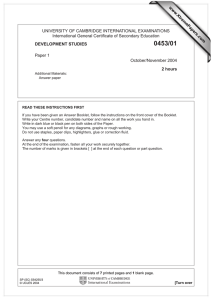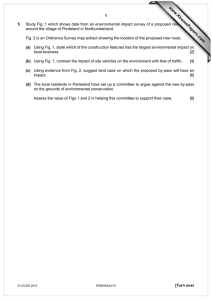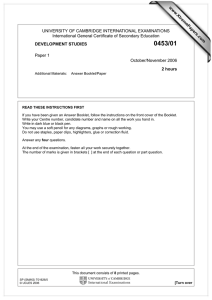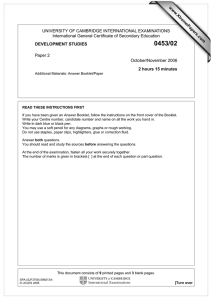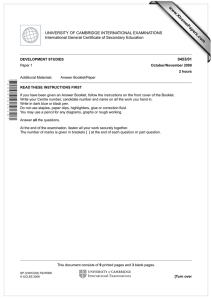UNIVERSITY OF CAMBRIDGE INTERNATIONAL EXAMINATIONS International General Certificate of Secondary Education www.XtremePapers.com
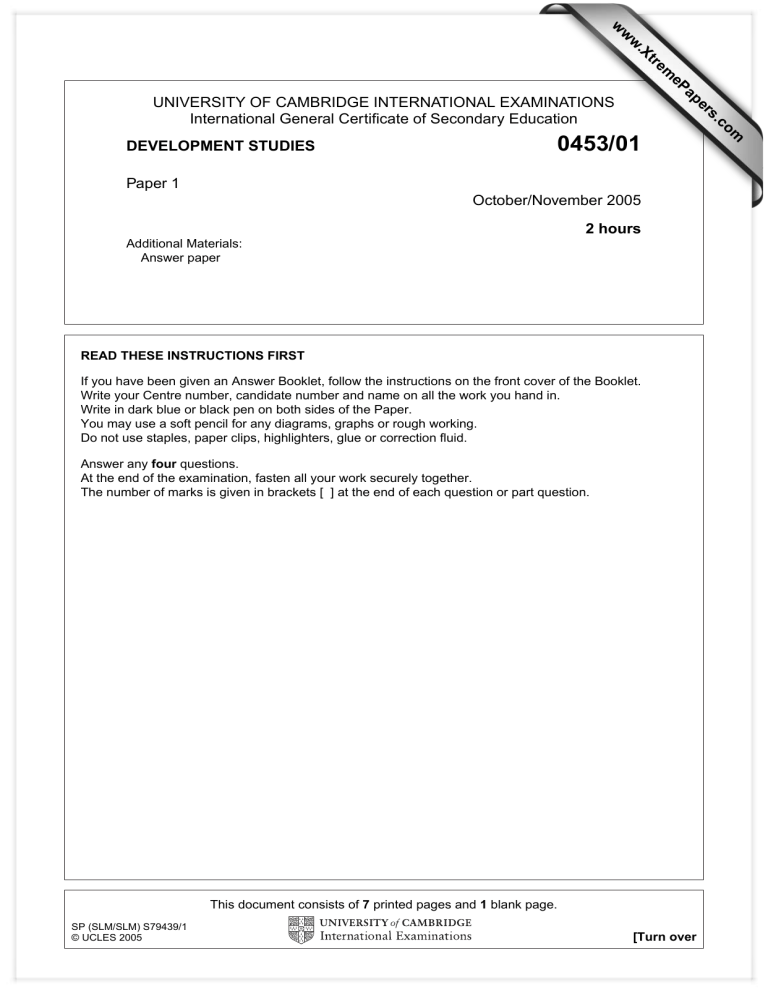
www.XtremePapers.com
UNIVERSITY OF CAMBRIDGE INTERNATIONAL EXAMINATIONS
International General Certificate of Secondary Education
DEVELOPMENT STUDIES
0453/01
Paper 1
October/November 2005
2 hours
Additional Materials:
Answer paper
READ THESE INSTRUCTIONS FIRST
If you have been given an Answer Booklet, follow the instructions on the front cover of the Booklet.
Write your Centre number, candidate number and name on all the work you hand in.
Write in dark blue or black pen on both sides of the Paper.
You may use a soft pencil for any diagrams, graphs or rough working.
Do not use staples, paper clips, highlighters, glue or correction fluid.
Answer any four questions.
At the end of the examination, fasten all your work securely together.
The number of marks is given in brackets [ ] at the end of each question or part question.
SP (SLM/SLM) S79439/1
© UCLES 2005
This document consists of 7 printed pages and 1 blank page.
[Turn over
2
1 Fig. 1 shows six people talking about their government’s new laws to protect forests.
We need to give the birds and animals somewhere to live.
I need wood to build my house.
F
A
B
I can earn more from selling wood and charcoal than from farming.
We have to think about future generations.
E
D
Wood is all I have for fuel.
C
I am only interested in selling lots of timber abroad.
Fig. 1
(a) Explain in your own words what is meant by “We have to think about future generations”. [1]
(b) Which of the speakers are mainly concerned about making money?
[2]
(c) (i) Give two reasons why so many households in the developing countries use wood as fuel.
[2]
(ii) Suggest how alternative fuels could be made available to households.
[1]
(d) Suggest three laws that might be brought in by a government to protect the forests.
[3]
(e) (i) Give three reasons why it is important that the birds and animals have somewhere to live.
[3]
(ii) Explain how the removal of forests contributes to global warming.
[3]
[Total: 15 marks]
© UCLES 2005 0453/01/O/N/05
3
2 Study Fig. 2 which is about childhood diseases in Africa.
Diarrhoea
Pneumonia
Malaria
Measles
Deaths per year of children under 5
800 000
1 500 000
1 000 000
Methods of prevention and cure
Clean water supplies, improved sanitation, oral rehydration salts
Primary health care, cheap antibiotics
550 000
Keeping areas clear of standing water, spraying
Immunisation (vaccination) programmes
Fig. 2
(a) (i) According to Fig. 2 which disease kills the most children in Africa?
[1]
(ii) Explain the difference between prevention and cure.
[2]
(iii) Explain why clean water and improved sanitation help to prevent the spread of diarrhoea.
[2]
(b) (i) How is malaria spread?
[1]
(ii) How will keeping home areas clear of standing water help to prevent the spread of malaria?
[1]
(c) Name one disease (not measles) that can be prevented by vaccination.
(d) Children that suffer from malnutrition are the most likely to die from childhood diseases.
[1]
(i) What is meant by malnutrition?
(ii) Explain the way different types of food are used by the body.
[1]
[3]
(e) Describe the way in which a health education programme could be used to help prevent disease in your own country.
[3]
[Total: 15 marks]
© UCLES 2005 0453/01/O/N/05
[Turn over
4
3 Study Figs 3A and B.
N. Africa
S. E. Asia
Sub-Saharan Africa
E. Asia
Latin America
Industrialised countries
Caribbean
0 5 10 15 20 25 30 35 percentage of households with no adult male
Fig. 3A
Women are becoming poorer
• Rural women the number of women living in poverty has increased; the men often have to leave their families to look for work.
• Urban women many women are just surviving in the informal sector.
• In less developed countries women work for 30% longer than men.
• In some industrialised countries women in formal sector jobs work 20% longer than men; women earn 40% less for the same work.
40
Fig. 3B
(a) (i) What percentage of households in Sub-Saharan Africa has no adult male?
[1]
(ii) Suggest three reasons why it is hard for women in rural areas when there is no adult male in the household.
[3]
(b) (i) What is meant by the informal sector?
(ii) Give two examples of work in the informal sector.
[1]
[2]
(c) (i) Give three reasons why women usually work longer than men.
[3]
(ii) What do Figs 3A and 3B show you about households in industrialised countries compared with those in the less developed parts of the world.
[2]
(d) Suggest three ways in which governments can improve the position of women.
[3]
[Total: 15 marks]
© UCLES 2005 0453/01/O/N/05
5
4 Study Fig. 4 which shows some statistics about Indonesia, a country in South East Asia, which stretches across 17 000 tropical islands.
Year
Population
Infant mortality rate per 1000 births
Life expectancy
1960 2000
100 million 204 million
128
41 years
45
65 years
% living in urban areas 15%
Rate of increase of urban population 3.7%
37%
4.4%
Poverty
100 million people live below the poverty line.
40 000 children live on the streets of the capital Jakarta.
Politics
1965 The dictator General Suharto seized power.
1965-98 Military dictatorship by Suharto and family.
1998 Suharto overthrown by democracy movement.
1999 a democratic republic set up.
2002 East Timor became independent of Indonesia.
Corruption and the power of the military continue to be a problem.
The Javanese are the largest ethnic group and hold most of the economic and political power.
Fig. 4
(a) (i) By how much did the population increase between 1960 and the year 2000?
[1]
(ii) What evidence is there to show that the health of the population of Indonesia improved between 1960 and the year 2000?
[2]
(b) Describe the changes that Fig. 4 shows in the urban population of Indonesia.
[2]
(c) (i) What is meant by the poverty line?
[1]
(ii) Suggest two reasons why the number of children living on the streets of Jakarta has increased.
[2]
(d) (i) What is a dictatorship ?
(ii) Give three characteristics of a democratic republic.
(iii) Use Fig. 4 to explain why Indonesia has had many violent civil disturbances.
[Total: 15 marks]
[1]
[3]
[3]
© UCLES 2005 0453/01/O/N/05
[Turn over
6
5 Study Fig. 5 which shows the balance of trade of selected countries in 2001 and the size of each country’s foreign debt.
300
250
200
150
Key
Imports
Exports
Debt
100
50
0
Brazil
India
Argentina
Nigeria
Bangladesh
Fig. 5
(a) (i) What is meant by the balance of trade ?
(ii) Which country has a balanced trade?
[1]
[1]
(iii) Name one country shown in Fig. 5 which has a negative (deficit) balance of trade.
[1]
(iv) Suggest three difficulties this negative balance of trade may create for a country.
[3]
(b) (i) What type of product do many least developed countries export?
(ii) Suggest three ways in which a country might try to improve its balance of trade.
[1]
[3]
(c) (i) What is meant by debt ?
(ii) How much larger is Argentina’s debt than the value of its exports?
[1]
[1]
(iii) Explain why it is difficult for a country to pay off its debts if it is not earning enough money from its exports.
[3]
[Total: 15 marks]
© UCLES 2005 0453/01/O/N/05
7
6 Study Fig. 6 which is a photograph of an informal settlement on the edge of Cape Town,
South Africa.
Fig. 6
(a) (i) In the developing world the proportion of the population living in cities is growing very rapidly. What is the name given to this process?
[1]
(ii) What name is given to the kind of informal settlement shown in Fig. 6?
[1]
(iii) Give three reasons why people are moving from the rural areas into these settlements.
[3]
(b) (i) What is the woman in the photograph doing?
[1]
(ii) Give two pieces of evidence from the picture that shows that people living in the settlement have some services.
[2]
(iii) What evidence is there that the buildings are becoming permanent.
[2]
(iv) Suggest two reasons why people may prefer to live in an informal settlement rather than another part of Cape Town.
[2]
(c) Give three ways (not the bringing in of water/electricity) in which the government of South
Africa can help to improve this type of settlement.
[3]
[Total: 15 marks]
© UCLES 2005 0453/01/O/N/05
8
BLANK PAGE
Copyright Acknowledgement:
Question 6 Photograph. Paula Jones © UCLES
Every reasonable effort has been made to trace all copyright holders where the publishers (i.e. UCLES) are aware that third-party material has been reproduced.
The publishers would be pleased to hear from anyone whose rights they have unwittingly infringed.
University of Cambridge International Examinations is part of the University of Cambridge Local Examinations Syndicate (UCLES), which is itself a department of the University of Cambridge.
0453/01/O/N/05


